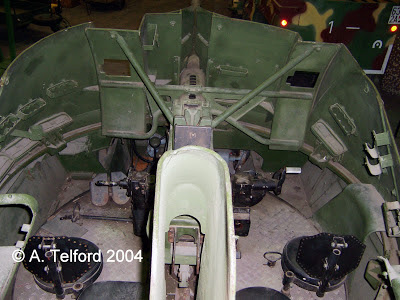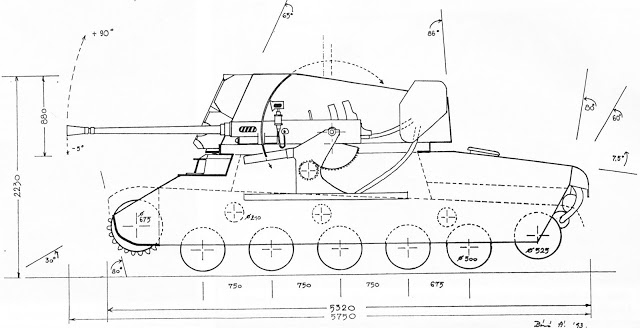The 40.M Nimród tank destroyer and anti-aircraft autocannon
- Jacky 95
- Apr 12, 2018
- 3 min read
You can find the full photo album for the Nimrod's interior at:
The design was based on the Swedish Landsverk L-62 vehicle which was seen on a display by Hungarian military and engineer representatives on October 25, 1936. Because Hungary already decided to buy the similar L-60 light tank and the 40mm Bofors autocannon was already manufactured in the country it was a logical and economical decision to buy the licence of the SPAAG too. After a series of tests the licence was bought by the Hungarian factory MÁVAG at the end of 1937. At the same time the factory ordered a slightly modified sample vehicle which arrived to Hungary in 1938. These modification did not affected the turret at the time. When the Hungarian licence built Bofors autocannon was built in the developers realized that the turret itself needed slight modifications too. In 1939 a series of test were made and more modifications were asked by military experts especially from the artillery branch. These modifications included the raise of the number of the crew from 5 to 6 with a spotting officer. This resulted further modification of the turret which gave the Nimród its characteristic look. The vehicle entered service as the "40.M Nimród tank destroyer and anti-aircraft autocannon" in 1940 which was later in the war modified to "36/40.M Nimród armored autocannon" since it no longer was effective as a tank destroyer but still served perfectly as an SPAAG. The first vehicles were given to the troops at the end of 1941. In 1941 Hungary bought the licence of the Büssing NAG type L8 V36 Tr engine and produced it as Ganz VIII VGT 107. The second series of the ordered Nimróds were built with the licence manufactured engines. A total of 135 Nimróds were built but there were 3 more turrets which were used by the Royal Hungarian River Forces.
The Nimróds were used both as SPAAGs and as tank destroyers throughout the war even if they were not very effective against Russian medium and heavy tanks - it used the 42/a.M páncélrobbantó gránát, a shaped charge, fin-stabilized shell against those. The Nimród's greatest strenght was its accuracy, the 40mm 36.M Bofors AA autocannon had minimal scatter and drop even at long ranges.
Hungarian 40 mm 36.M AA autocannon
Hungary bought the licence of the Swedish Bofors 40 mm L/60 gun and started producing it in 1936. This mechanized-AA artillery gun was completly identical to the original one in all specifications.
By the end of 1942 Hungary ordered 1084 autocannons from the factories in total but between 1936 and 1944 only 430 were produced and another 220 for Germany. The autocannon was so precise and effective that Hungary started to use it as a duel-purpose gun in 1940-41; she used it for AA and AT roles too. According to the soldiers the gun was so precise that they could take out the driver of a truck from 2-3 kilometers with one shot. Hungary still used these guns against ground targets in 1943-44 but with special ammunitions.
In 1943 a new shaped charge, fin-stabilized shell was intorduced, the 42.M páncélrobbantó gránát ("armor exploder grenade") which increased the gun's armor piercing capabilities.
A new AP shell was issued to the gun too, the 43.M magvas páncélgránát ("cored armor-piercing"), Hungary did not had the materials nor the technology to produce tungsten so these AP shells had a common steel core.
Rate of fire: 120 shots/min.
Gun depression, elevation: -5, +90
The 36.M autocannon was the main weapon of the Hungarian Nimród SPAAG too.
It was also fixed on 3 or 4 Hungarian built Me 210 Ca-1 heavy fighters.
The Nimrod used the following four-shell combinations
HE-T/HE-T/HE-T/HE-T (only HE)
APBC-T/HE-T/APBC-T/HE-T (cored armor piercing)
APHEBC-T/APHEBC-T/APHEBC-T/APHEBC-T (cored and explosive)
36.M APHEBC-T (850m/s)
100 m - 50 mm - 60°
500 m - 40 mm - 60°
1200 m - 32 mm - 60°
1600 m - 25 mm - 60°
43.M APBC-T (850m/s) combined with HE shells (APBC-T/HE-T/APBC-T/HE-T)
100 m - 58 mm - 60°
500 m - 46 mm - 60°
1200 m - 37 mm - 60°
1600 m - 29 mm - 60°
42/A.M fin-stabilized shaped charge (110m/s)
180 mm - 90°
General Specifications.
length: 5,750m
width: 2,300m
height: 2,230m - 0,350m from the ground
track width: 0,286m
track length: 0,065m
track links: 132
max climb: 44,44%
step: 0,6-0,8 m
trench: 2-2,02 m
ford: 0,7 m
turning radius: 5 m
max weight: 11t
pressure on the ground: 0,60 kg/cm2
radio: R-5 radio (stick radio antenna)
crew: 6
max speed: 46,5 km/h on road
ENGINE
name: Büssing NAG Type L8 V36 Tr /Ganz VIII. VGT. 107 (1st series was built with Büssing, 2nd series with Ganz)
power: 155 hp a 2700 rpm
power-to-weight ratio: 16,4 hp/t
engine displacement: 7913cc
gears: 5 + 1
max speed 5th gear: 46,5 km/h
max speed reverse gear: ?
fuel: petrol
fuel capacity: 253L
autonomy: 200km
Highest theoretical gun elevation speed: 11 degrees/second (8-9 seconds to 90 degree)
Highest turret rotation speed: 22,5 degrees/second (16 seconds to 360 degree)
Optic, and image of the 42/A.M fin-stabilized shaped charge



























































Comments